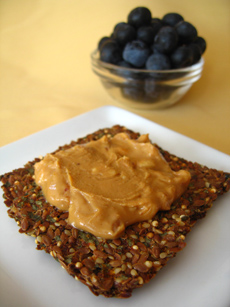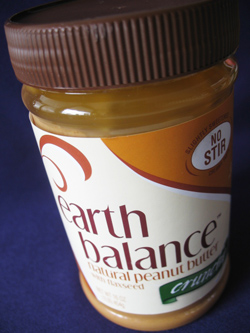
 A very healthy snack: Earth Balance natural PB on a raw seed cracker from Yaya’s Raw Rah, with fresh blueberries. Photography by Emily Chang | THE NIBBLE. A very healthy snack: Earth Balance natural PB on a raw seed cracker from Yaya’s Raw Rah, with fresh blueberries. Photography by Emily Chang | THE NIBBLE.
|
EMILY CHANG is a writer based in New York City.
|
|
August 2009 |
 |
Earth Balance Natural Peanut Butter & Almond Butter
Nut Butters We’re Nuts About
Page 1: Traditional (“Regular”) Peanut Butter Versus Natural Peanut Butter
CAPSULE REPORT: With the 2007 government proclamation that “trans fat is bad for you,” some people switched to smaller, natural peanut butter brands while big manufacturers reformulated their products. And some people who switched stayed there, because to the refined palate, natural peanut butter tastes better—not to mention no preservatives and no—or far less—sugar and salt. We’re big fans of Earth Balance Peanut Butter, in creamy and crunchy varieties. The company also makes an equally delicious Almond Butter, which has become a favorite of ours. The products are certified OU kosher, and are gluten-free and vegan. This is Page 1 of a 2-page article. Click the black links below to view Page 2.
Introduction To Natural Peanut Butter
Peanut butter is a food for the ages. Perhaps Bill Cosby phrased it best: “Man cannot live by bread alone. He must have peanut butter.” Though some may complain about its tendency to stick to the roof of the mouth, or lament that there’s yet another PB&J for lunch, when it comes down to it, Americans are still stuck on peanut butter.
The question is, what kind of peanut butter do we love best, and is it the kind that’s best for our health? For years, classics like Skippy, Jif and Peter Pan ruled the U.S. supermarket aisles. But when the uproar over trans fats broke out, these traditional PB standbys scrambled to reformulate their products, leaving natural peanut butters to help pick up the pieces.
If you transition from traditional to natural peanut butter, you’ll probably find better peanut flavor along with a more pure peanut experience. The problem is that natural peanut butter can lack several appealing aspects of mass-marketed peanut butters, and may not be as popular with an American palate trained to like foods with additives.
What’s Different With Natural Peanut Butter
We’re focusing our comments on peanut butter, but the same would apply to any mass-marketed nut butter (e.g., almond butter). Check the labels!
- No Sweeteners. Some natural peanut butters are made with a whopping two ingredients—just peanuts and salt—meaning that they lack the large dose of HFCS of other sweeteners that many supermarket peanut butters have. Other natural PBs add a touch of honey or agave (like Earth Balance), which are natural, low-glycemic sweeteners. (Read more about sweeteners.)
- Coarser Texture. To some, the liability of natural-style peanut butter is the loss of the ultra-smooth texture. Natural peanut butters are not minimally processed, i.e., not whipped and emulsified into a creamy smoothness.
 Oil Separation. Some natural-style peanut butters need to be stirred before consumption in order to recombine the oils and solids that naturally separate in the jar if the product is minimally processed. (You’ll also notice this with some natural yogurts, where the liquid whey will separate at the top and can be drained off or stirred back in.) Some consumers are so convenience-oriented, they don’t like this extra step—or perhaps they don’t like being reminded about how much fat is in peanut butter! Oil Separation. Some natural-style peanut butters need to be stirred before consumption in order to recombine the oils and solids that naturally separate in the jar if the product is minimally processed. (You’ll also notice this with some natural yogurts, where the liquid whey will separate at the top and can be drained off or stirred back in.) Some consumers are so convenience-oriented, they don’t like this extra step—or perhaps they don’t like being reminded about how much fat is in peanut butter!
Photo: Unlike some natural peanut butters, Earth Balance doesn’t require stirring to reintegrate separated oil.
- Refrigeration. Some natural peanut butters need to be refrigerated, meaning that they are nowhere near as easy to spread directly on a slice of bread. Unfortunately, it appears that what made peanut butter so easy to spread were, in fact, the very same trans fats that do damage to our health—but apparently not to our taste buds. (Earth Balance does not require refrigeration, in fact, recommends against it for better spreadability.)
What are you trading off? Here are examples of what’s in traditional PB vs. a natural PB like Earth Balance:
- Jif Creamy Peanut Butter: Roasted peanuts, sugar, molasses, fully hydrogenated vegetable oils (rapeseed [canola] and soybean), mono- and diglycerides, salt.
- Earth Balance Peanut Butter: Peanuts, agave syrup, palm fruit oil, salt, enhanced with flaxseed for ALA Omega 3 essential acids. Palm fruit oil, as opposed to palm kernel oil, contains heart-healthy carotenoids. Read more about the two different palm oils.
Note that now, large manufacturers are also producing natural peanut butter, and to us, they taste far superior than the traditional varieties. Check ‘em out. Earth Balance, by the way, is no mom-and-pop operation; it is owned by a publicly-traded company that also sells the Smart Balance line of foods.
Are There Still Trans Fats In Regular Peanut Butter?
In 2008 and 2009, traditional manufacturers reformulated “trans-fat-free” versions of their peanut butter. But although the front of the package may claim that there is no trans fats, the ingredients label often still includes partially hydrogenated oils (trans fats). Confused? The FDA currently allows companies to claim zero grams of trans fat as long as the product contains less than 0.5 grams of trans fat per serving.
As miniscule as that amount might sound, the average American is estimated to consume six pounds of peanut butter and peanut products per year, according to the National Peanut Board. The Board also estimates that the average American child will have consumed 1,500 peanut butter and jelly sandwiches by the time he or she graduates from high school. With those significant figures, you should consider a natural peanut butter.
Frankly, we think natural PB tastes a lot better, too. In side-by-side tests, there’s simply no comparison. Natural PB is more peanutty. Traditional peanut butter is saltier and sweeter (from unnecessary sweeteners). What traditional PB does offer, the creaminess from emulsification, may seem more attractive at first blush; but after it’s in a sandwich, you simply don’t notice.
Go To Page 2: Varieties Of Earth Balance Spreads
Return To The Article Index Above
All material

|





 Oil Separation. Some natural-style peanut butters need to be stirred before consumption in order to recombine the oils and solids that naturally separate in the jar if the product is minimally processed. (You’ll also notice this with some natural yogurts, where the liquid whey will separate at the top and can be drained off or stirred back in.) Some consumers are so convenience-oriented, they don’t like this extra step—or perhaps they don’t like being reminded about how much fat is in peanut butter!
Oil Separation. Some natural-style peanut butters need to be stirred before consumption in order to recombine the oils and solids that naturally separate in the jar if the product is minimally processed. (You’ll also notice this with some natural yogurts, where the liquid whey will separate at the top and can be drained off or stirred back in.) Some consumers are so convenience-oriented, they don’t like this extra step—or perhaps they don’t like being reminded about how much fat is in peanut butter!